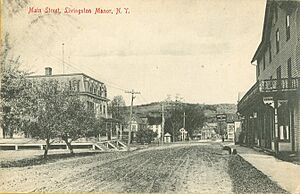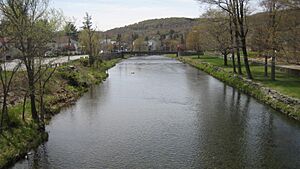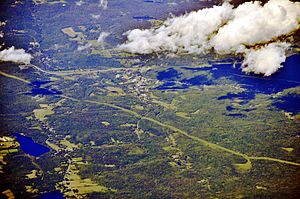Livingston Manor, New York facts for kids
Quick facts for kids
Livingston Manor, New York
|
|
|---|---|
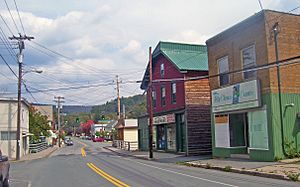
View north along Main Street
|
|
| Etymology: From Livingston family | |
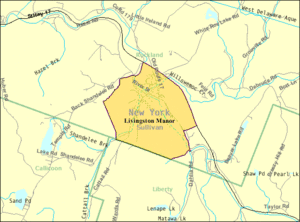
U.S. Census map of Livingston Manor
|
|
| Country | United States |
| State | New York |
| Region | Catskills |
| County | Sullivan |
| Area | |
| • Total | 3.26 sq mi (8.43 km2) |
| • Land | 3.25 sq mi (8.40 km2) |
| • Water | 0.01 sq mi (0.03 km2) |
| Elevation | 1,401 ft (427 m) |
| Population
(2020)
|
|
| • Total | 1,053 |
| • Density | 324.50/sq mi (125.31/km2) |
| Time zone | UTC-5 (Eastern (EST)) |
| • Summer (DST) | UTC-4 (EDT) |
| ZIP Code |
12758
|
| Area code(s) | 845 |
| Exchange | 439 |
| FIPS code | 36-42928 |
| GNIS feature ID | 0955750 |
Livingston Manor is a small community in Sullivan County, New York, United States. It is known as a hamlet and also a census-designated place. In 2020, about 1,053 people lived here.
Livingston Manor is located in the southern part of the town of Rockland. A major road, New York State Route 17, passes nearby.
Contents
History of Livingston Manor
In the late 1800s, this area was named Livingston Manor. It was named after the Livingston family, who were important in New York. However, this community was not part of the original "Livingston Manor." That was a huge estate granted by the English Crown in 1715. The original estate was about 60 miles (97 km) east of here.
The land where Livingston Manor now stands was part of a large land grant called the Hardenbergh patent from 1716. This patent covered much of the Catskill Mountains.
In 1750, a man named Robert Livingston bought 95,000 acres (384 km²) in this area. He was the third and last "Lord of the Manor" of the original Livingston Manor. He sold or leased most of this land by 1780. Later, in 1822, his nephew, Dr. Edward R. Livingston, received 8,441 acres (34 km²) around a place then called Purvis, New York.
Railroad and Name Change
In 1880, the New York, Ontario and Western Railway reached Livingston Manor. This brought many visitors and helped the community grow. Passenger train service stopped in 1953, and the railroad closed in 1957.
In 1882, the people of Purvis decided to change the name to Livingston Manor. Edward Livingston's home was said to be where the village firehouse or the Rockland, New York Town Hall is today.
Early Settlers and Newcomers
The Benton family were some of the first settlers here. They came from Connecticut in the late 1700s. Other families who settled nearby included the Bascoms, Stewarts, Wests, and Williams. Some of their descendants still live in the area today.
In the late 1800s and early 1900s, many immigrants from Eastern Europe came to the village. Jewish immigrants built the Agudas Achim Synagogue. It is now a historic building.
Fly Fishing in Livingston Manor
Livingston Manor is often called the "birthplace of fly-fishing in the United States." This is because of the great trout fishing in the 27-mile (43 km) long Willowemoc Creek. This creek flows between Livingston Manor and Roscoe. The Catskill Fly Fishing Center and Museum is located on the edge of town, right on the Willowemoc Creek.
Today, the fish in the Catskills are cared for by state wildlife experts. All the fish stocked in the Catskills and the New York City water supply reservoirs are raised at the Catskill Fish Hatchery. This hatchery is just northeast of Livingston Manor in DeBruce, New York.
Since 2004, the community has held an annual Trout Parade. It's a fun event with marching bands and fire trucks.
Education
The Livingston Manor Central School District runs the public schools in the area. These include Livingston Manor Central School for middle and high school students, and Livingston Manor Elementary School. The school's sports teams have been very successful. The Varsity softball team won state titles in 2010 and 2011. The Boys Varsity baseball team won a state title in 2011.
Geography and Downtown Area
Livingston Manor is located at 41°53′46″N 74°49′38″W / 41.89611°N 74.82722°W. The area covers about 3.1 square miles (8.0 km²), all of which is land.
Downtown Attractions
The downtown area of Livingston Manor is mostly along Main Street. Here you can find several restaurants, a large grocery store, and various art and antique shops. The Catskill Art Society has a center on Main Street called the CAS Arts Center. It has art exhibits and offers art classes for the community.
Flood Concerns
Sometimes, heavy rain causes the Willowemoc Creek to rise. This can lead to flooding in downtown Main Street and other low-lying areas of the hamlet.
Population Information
| Historical population | |||
|---|---|---|---|
| Census | Pop. | %± | |
| 2000 | 1,355 | — | |
| 2010 | 1,221 | −9.9% | |
| 2020 | 1,053 | −13.8% | |
| U.S. Decennial Census | |||
In 2000, there were 1,355 people living in Livingston Manor. About 33.8% of households had children under 18. Many people lived alone or in families. The community is served by a dedicated Volunteer Fire Department and a Volunteer Basic Life Support Ambulance Corps.
Notable People from Livingston Manor
- Irving Berlin owned a farm nearby.
- Sam Morrison, a jazz saxophonist and flutist.
- John Mott, who won the 1946 Nobel Peace Prize, was born here.
- Joan Wulff
- Lee Wulff
Places of Worship
- Methodist Church
- Presbyterian Church
- Cornerstone Community Church (Grooville Free Methodist)
- Main Street Bible Fellowship
- Saint Aloysius Catholic Church /De Bruce branch of Catholic Church open in summer.
- Agudas Achim Synagogue
- Our Lady of Lourdes Monastery
- Willowemoc Baptist Church
- Lew Beach Community Church
See also
 In Spanish: Livingston Manor para niños
In Spanish: Livingston Manor para niños




